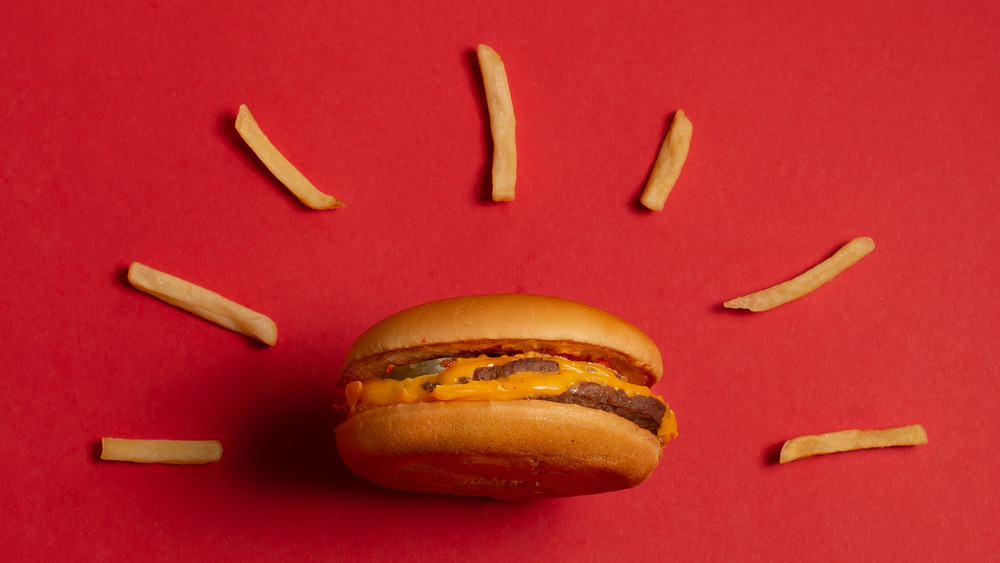The One Burger McDonald's Wishes You Forgot
You can't blame McDonald's for trying new things. After all, the Chicken McNugget was a new fast-food concept in 1983, and we all know how that turned out. A version of chicken nuggets is available at most fast-food places now, and Americans ordered 2.3 billion servings of nuggets over a recent 12-month period (via Taste of Home).
Not every new menu item is going to be a success, butut that's okay. As Elon Musk once said, "If things are not failing, you are not innovating enough" (via Fast Company). He should know. He blows up rockets for a living. McDonald's is only trying to give customers what it thinks they want. Every once in a while, the chain fails as spectacularly as one of Musks' spaceships (via YouTube). Musk hopes you forget about those as you board your first flight to Mars — just as McDonald's hopes you forget about these burgers: two honorable mentions, and the biggest McDonald's burger failure ever.
Second runner-up goes to the McLean Deluxe. McDonald's thought it hit paydirt with this burger, which had 9 percent fat in its patty rather than the more usual 20 percent. It seemed like the perfect fast-food item for the fat-conscious 1990s, so McDonald's rushed it to all of its restaurants nationwide. The McLean had a few issues. It was expensive, for one, and it didn't taste good, for another (via The War Eagle Reader). According to The Impulsive Buy, the McLean debuted in 1991 and hung on until 1996 before being discontinued.
The McAfrika was a PR nightmare - but not everyone thought so
McDonald's in Norway drew fire from international relief organizations in 2002, after billboards in Oslo announced the arrival of a limited-time McAfrika burger. The McAfrika was beef, cheese, tomatoes, and salad in a pita and was said to be based on an authentic African recipe (via BBC). Never mind the cultural appropriation. An estimated 12 million people in southern Africa were starving at the time. "Launching a burger with such a name at the same time Africa is facing perhaps its worst hunger catastrophe ever is very bad timing," an official from Norwegian Church Aid said at the time. McDonald's admitted it wasn't a good look for one of the world's richest nations to have a hamburger named after a continent experiencing massive food shortages. Still, they kept the limited-time promotion going until it was scheduled to end.
The McAfrika is only a runner-up for the burger McDonald's most wishes you would forget. That's because it was only sold in Norway (though Wikipedia says Denmark, too), and one African organization in Norway actually supported the McAfrika.
The head of African Youth in Norway said the relief organizations' anger was misplaced. "Finally we see someone who uses the continent's name in a positive way," Lamisi Gurah of African Youth in Norway said. "Even though there is a terrible shortage of food in some areas of Africa, this is far from the situation all over the continent."
McDLT's worst ingredient was the Styrofoam
The McDLT, sold from 1984 to 1991, had a few things in its favor, says BuzzFeed. The burger was tasty, and it didn't remind anyone of starving people in Africa. The problem was that it came with an extra side of Styrofoam. All of McDonald's burgers came in Styrofoam containers in the 1980s, but the McDLT was served in a double-wide clamshell. Half held the beef patty and the bottom bun. The other half held the lettuce, tomato, cheese, and top bun. Whatever benefits were gained from keeping the hot side hot and the cool side cool were outweighed by the double-dose of Styrofoam McDonald's was putting out there with each McDLT order.
The rise of the McDLT coincided with increasing public awareness of Styrofoam's impact on the environment (via Chemical & Engineering News). Styrofoam's ingredients are cancer-causing, and the EPA found styrene in the breast milk of women during a 1982 study (via The Baltimore Sun). Styrofoam takes hundreds of thousands of years to break down but crumbles into small pieces so that birds and fish end up eating it (via CBS News). McDonald's consulted with the Environmental Defense Fund, and by the early 1990s, its Styrofoam clamshells were history – along with the McDLT.
As McDonald's works toward its goal of 100 percent sustainable packaging (via USA Today), the chain would rather you forget that it once was a huge source of Styrofoam, with the biggest culprit of all being the McDLT.


